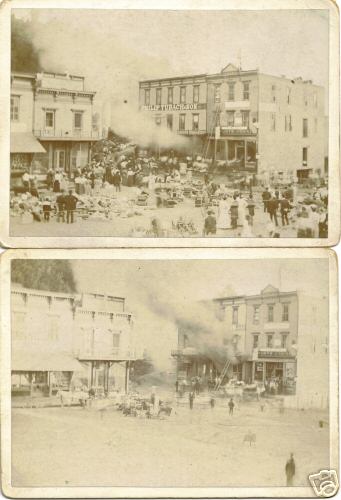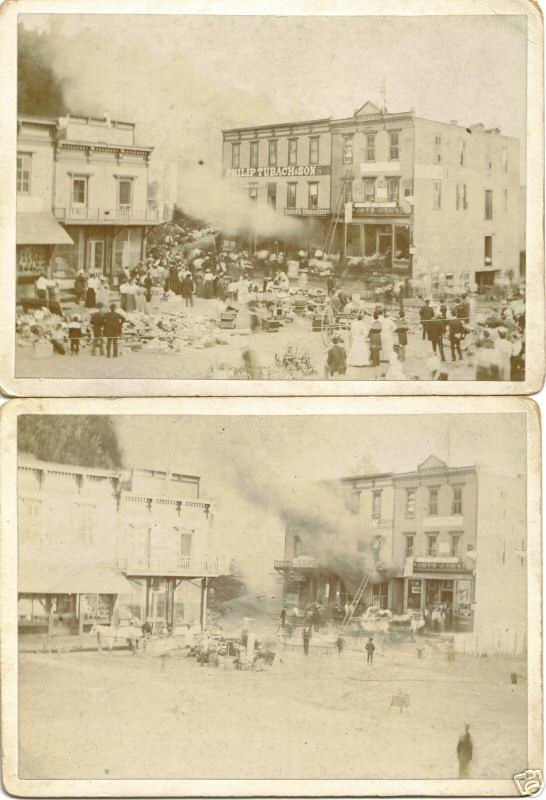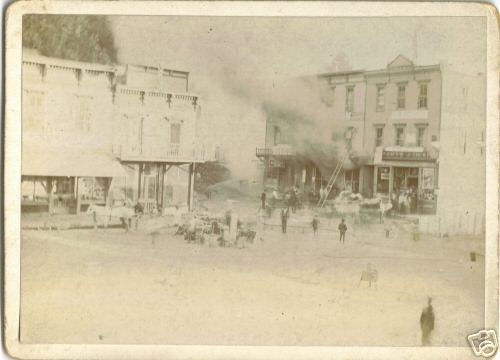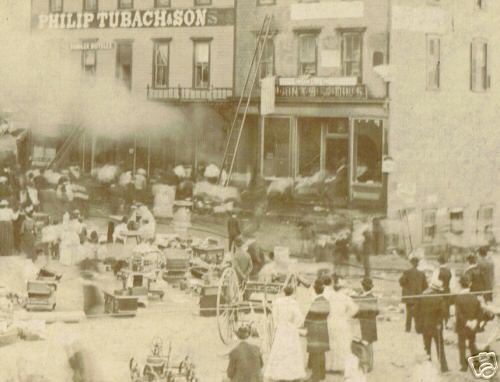




Scenes from the Great Dushore Fire of 1898
Photos by Carol Brotzman
Source: A set of 1900 photos auctioned on eBay in 2008





Scenes from the Great Dushore Fire of 1898
Photos by Carol Brotzman
Source: A set of 1900 photos auctioned on eBay in 2008
SELECTED DUSHORE FIRES
The following excerpt from The Benton News, January 26, 2008, tells a gripping story of Dushore and its fires:
...........
When the fire alarm sounds, we know that the volunteer fire, EMS and rescue services will take care of the situation.
What happens when there is no one to fight the fire? What if the major industry of a county is wiped out by
the fire?
A good way to tell a story like this is to remember the disastrous fire in Dushore twenty-five years ago on this
date in 1983..........
This story isn't about the fires experienced in the Borough of Benton over the years. The story unfolded in Dushore,
30 miles due north of Benton at the intersection of Routes 487 and 220. To tell the story correctly, it is
necessary to head back to Dushore for the events of June 6, 1898, a day when the dreaded fire alarm sounded at
six in the evening. A large "three-story block," to use the term townspeople used, caught on fire. When the
alarm sounded, according to the Wilkes-Barre Times the next day, every resident of Dushore showed up at
the fire. Generally, the residents were dressed in their best clothes, but they didn't stop to change
but went "to work with a will to stay the work of the flames."
The buildings on fire were identified as "blocks." The "Biddle block" was occupied by Samuel Cole, owner of a
hardware store. His store, which carried one of the "largest stocks of hardware" in Sullivan County, soon
was ablaze on all four stories of the store. The next "block" was occupied by a furniture store and undertaker.
It was known as the Tubach Block. It was three-stories high. The Jacob Yonkin block came next, a three-story high
"carriage repository" and harness shop. The store carried a large stock of agricultural implements.
The Times article reported that the fire "originated from some mysterious cause." The fire began near a
partition in one of the basements. Among other things, the building housed gasoline, dynamite and other explosives.
After about four hours, the blaze was extinguished. Damage in the three buildings--remember we are talking 1898 here--
was initially estimated at $6,700. One of the buildings burned for four hours--but the hearty people of the
community decided that the building could be rebuilt. .....
Injuries were few for the amount of fire. One employee fell and broke several ribs. A ladder snapped and a
fireman was thrown to the ground. His injuries were so bad that he was unconscious for some time. *
Fires in Dushore were not over. On March 11, 1898, a grist mill and a sawmill in Dushore were destroyed by fire.
The two-alarm fire had engulfed the large building on the side hill by 10 PM. The building--six stories on one
side and three stories on the other--was mostly filled with grain and with flour. The superintendent of the
mills was a Mr. Wells, who "suffocated with smoke." He had to be dragged from his office just as flames
surrounded the room in which he lay........
The loss to Dushore was huge. The mill was old, but the sawmill and the gristmill were vital to the area. The
Wilkes-Barre Weekly Times reported that the gristmill did all the grinding for the entire county. There was
speculation as to the cause of the blaze. The mill had been in good running order since the days when it was built
by a Mr. Headley. A foundry was badly scorched and was saved only through the hard work of "the home people with
buckets." Four houses "across the gully" caught fire, but were saved. The fire was later though to have
been started by sparks coming from the saw mill. The loss was estimated at $10,000.
In 1909, the son of a former Associate Judge of Sullivan County suffered terrible burns of his body when
his doctor was bathing him in the family home in Dushore. The 21-year-old son suffered from "sciatic rheumatism"
and as a cure his doctor decided to bath him in alcohol. The room was dark, the November 26, 1909,
Times Leader reported, and "in order to make an examination the doctor picked up a match and lighted
it in preparation to lighting a lamp. The room was filled with the fumes of the alcohol at the time and in an
instant they were ablaze and the body of the young man was a sheet of flames. The young man's condition was so
bad he could not help himself and the physician's hands were saturated with alcohol and he couldn't assist.
Fortunately the father was nearby. He grabbed a blanket from the bed and succeeded in smothering the flames
and saving his son's life. The hands of the boy's mother were also severely burned during the rescue effort......
This thread began with the intent of telling you about the fire in Dushore twenty-five years ago on this date.
That fire, according to an article in the Sullivan Review, brought 11 fire companies and 150 firemen to
assist in some capacity in fighting the blaze. The cost to the community was a reported million dollars.
The buildings that had stood in the location of the fire were destroyed and adjacent buildings like the
Northern Central Bank and the Ben Franklin Store had exterior damage. Across Water Street, the Sullivan Review's
Print Shop was reported to have "glowed orange from the heat."
The next time you stop at the only stop light in Sullivan County--which is in Dushore--remember the many fires
this fine community has endured.
* The Wilkes-Barre paper identified the injured parties as James Cook, one of Mr. Cole's employes,
who fell, had several ribs broken and was injured internally while fighting the fire. The other injury occurred when
a ladder broke, throwing David Wood to the ground. He was reportedly unconscious for some time.
Copyright © 2010 Robert E. Sweeney and Individual Contributors. All Rights Reserved. Prior written permission is required from Robert E. Sweeney before this material can be printed or otherwise copied, displayed or distributed in any form.This is a FREE genealogy site sponsored through PAGenWeb and can be reached directly at ~Sullivan County Genealogy Project (http://www.rootsweb.com/~pasulliv)
Back to the The Sullivan County Genealogical Web Page